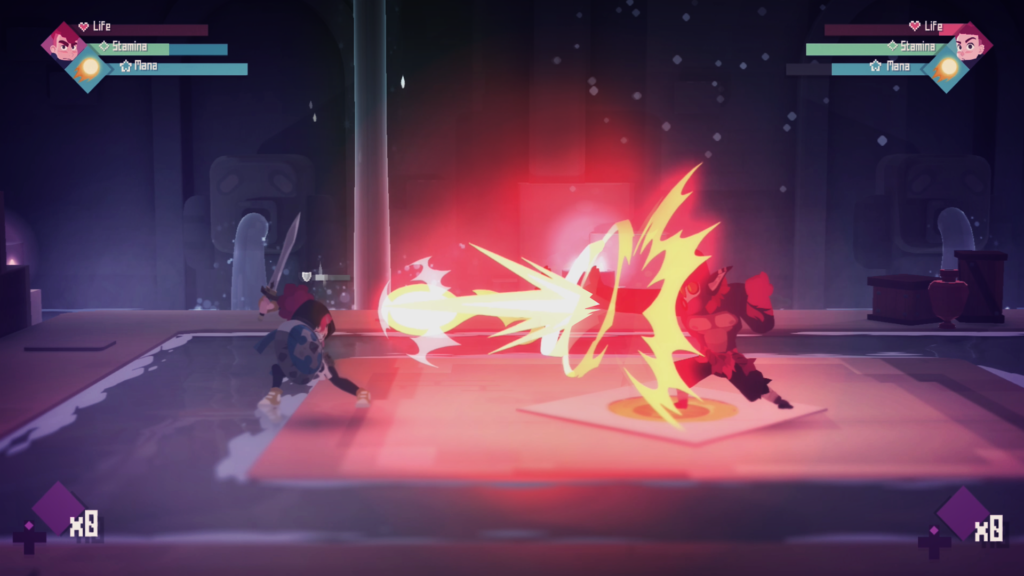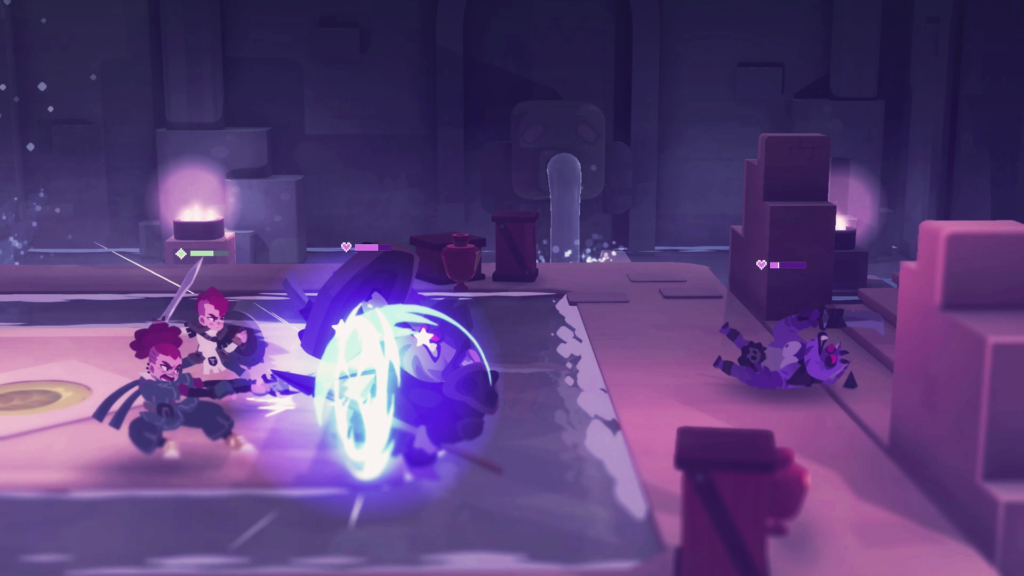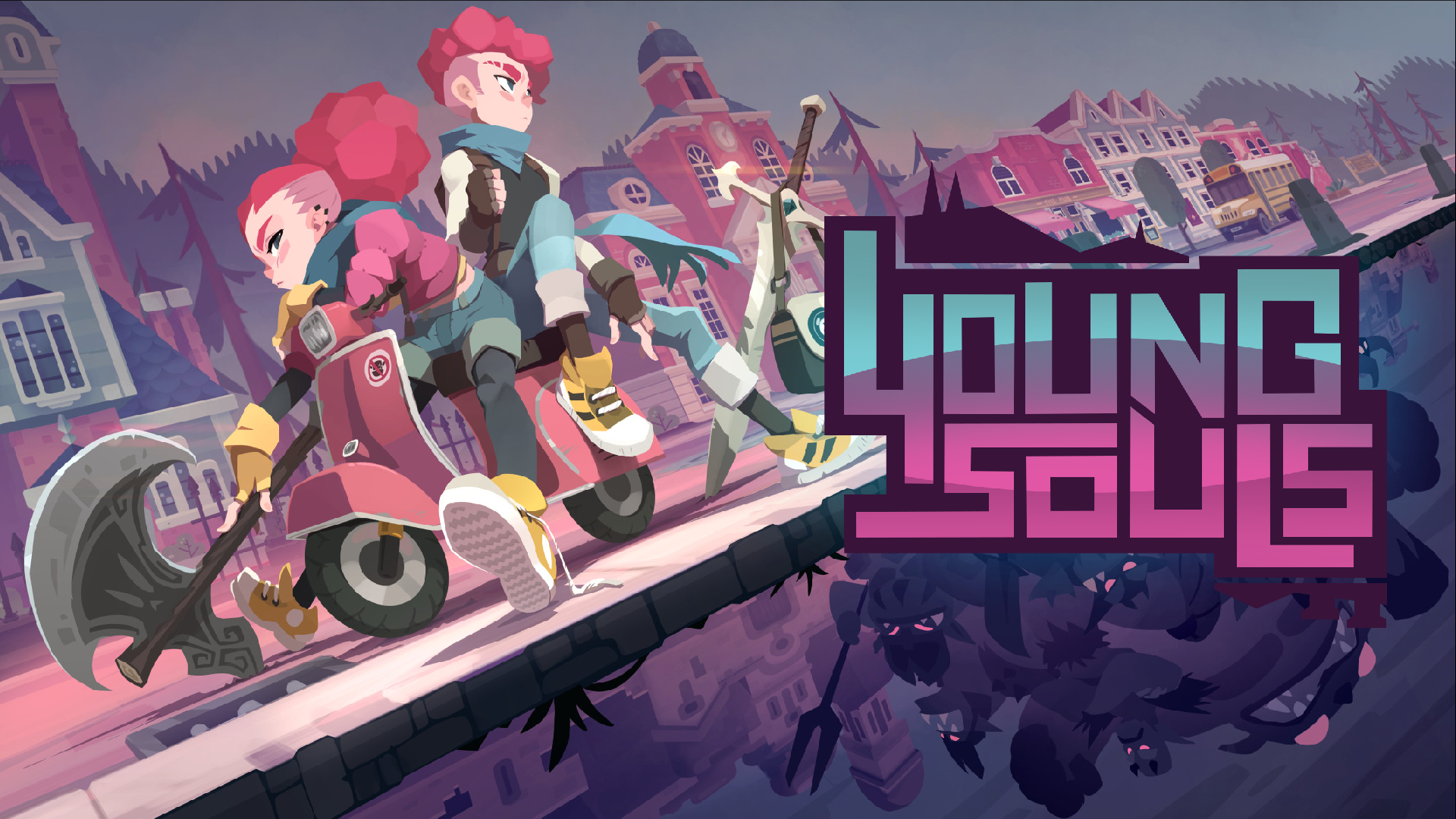From 1P2P & The Arcade Crew, Young Souls is a very stylish one or two-player 2D sidescrolling brawler, combined with a deep and thoughtful story and a surprising smattering of action RPG tendencies.
You play a pair of dysfunctional teenage twins, Jenn and Tristan, pawed from foster family to foster family until they are taken in by an absent-minded and terminally distracted (if not kind-hearted) scientist. Angry, sweary misfits, the twins are unpopular in their local Mid-Western Americana town, but their troubles become more than nasty gossip when militaristic goblins kidnap the Professor. With help from the shaman, Baldwin, and the prisoners they rescue along the way, Tristan and Jenn wage a teenage war against the Gobben army that is amassing to invade the surface world and hopefully save their foster father. After all, they’re in the right… aren’t they?
First things first, Young Souls offers a ton of accessibility options. Vision and hearing-based tweaks and difficulty sliders, including toggling the amount of damage both you and your enemies cause. It’s all good stuff, and options like this should be available in everything.
The gameplay is probably, what you expect of it. Move right, fight baddies with a combo-able attack button, jump button for air moves, a block, and a dodge that both use stamina. A weapon-specific super attack is carried out by a separate button fueled by a fighter-like special bar. Similarly, from one on one brawlers, you have a switch button to change the playable twin, like Marvel Vs Capcom. The resting character then slowly regenerates up to two-thirds of their lost health. A fitting mechanic, given the twin leads – I decked Jenn out as the heavy hitter and Tristan as the tank, so when she was low on health, I could swap to Tristan and stall while Jenn healed. Of course, this button isn’t there if you play the game in Co-Op, a big selling point, as we all know co-op brawlers are a gift given to us by our Lord, Saint Haggar of Metro.
As you beat enemies, you’ll gather Goblin cash, craft resources specific to each level, weapons, and armour, secondary weapons (like bombs, bows, and grappling hooks) healing potions and keys. You can also rescue Goblins that offer their services in exchange for cash or rare resources. Weapons and armour can be upgraded to inflict to protect the pair from damage (but not to remove their weaknesses, so think about what you upgrade). Similarly, secondary weapons can be boosted for more utility effects. You can also go up to the surface, to the human town to trade your excess stuff for human bucks at the pawnshop, change your clothes, work out at the button-bashing gym, or buy the most vital upgrade of all – magical sneakers.

And that’s most of Young Souls. Lush 2D artwork that looks like a Cartoon Network toon coupled with easy to pick up combat that will often throw a wrench in your works. Parry, dodge, upgrade your weapons and go back to earlier areas with your keys (very, very easily thanks to the teleport system, accessible from the pause menu) to get new stuff. Basic, a little repetitive at times, but rewarding.
At this point, I ask that if you play games for the story and you like the sound of Young Souls, go buy it and play it. If not, be warned we’re getting into moderate spoiler territory.
Ahem.
So.
What I personally think is the best aspect of Young Souls is how the game, slowly at first but gets more and more blatant as the story continues, questions whether what you are doing is right and just. At first, the answer is obvious; the Gobben army kidnapped the Professor, killed many of their own, and are planning to invade and destroy the town. This is just a rescue mission to stop the baddies and get the old man back… but as you continue, more and more enemies comment on the amount of Gobbens you’ve killed.

It’s easy to scratch this up to it being a war… but you made it a war. The Professor wanted to bring the Gobben to the surface, but some, like their leader, despised compromise; especially with the humans who had forced them underground millennia ago. The Dwarvengobben didn’t decide to build a drilling machine until the twins retaliated. You did this.
You can tell yourself you’re fighting for the people back home, and the free Goblins, but you’re still killing more and more. And the game loves to remind you of such. The Gobben artificer, who dons a battlesuit not to fight you, but to protect the artefact you’re going for, is killed when her suit backfires. With her conscience no longer guiding the project, the Dwarvengobben uses her technology for the siege. Furthermore, every boss from that point personally hates you, blaming you for her death. This got personal. You made it personal.
At the end of the day, Young Souls isn’t a game with branching pathways or a morality system. It’s a linear dungeon crawler, left-to-right, with upgrades. 1P2P use this framework to hide their story in plain sight; the story requires you to deliver the first blow, to wage war, to kill indiscriminately because that’s what you do in Brawlers. You plough forward, with no thought towards the ramifications of your actions.

Throughout the game, I questioned the title. Twin Souls would have made more sense, Young seems just to be an obvious fact. But the more I pondered, the more it made sense. The Twins think they have everything sorted out with abrasive personalities, tough demeanours, and they can hold themselves in a fight. Truthfully, though, they’re just kids. They start a war, kill as if they are in a videogame, are reticent to question the Gobbens’ morals, and are more than happy to steal artefacts from one party to give to another, just based on race. That behaviour ultimately leads to tragedy before it can lead to peace. But, when you’re young, you learn lessons by committing mistakes. Young Souls, it works.
Young Souls questions that mentality, and it’s a breath of fresh air for the by-the-numbers genre side-scrolling beat-em-ups have become.

